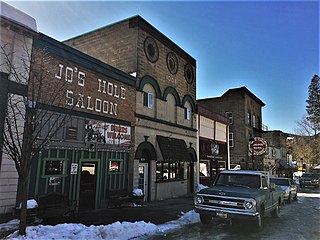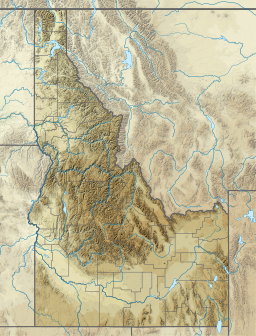
Coeur d'Alene is a city and the county seat of Kootenai County, Idaho, United States. It is the largest city in North Idaho and the principal city of the Coeur d'Alene Metropolitan Statistical Area. At the 2020 census the city's population was 54,628. Coeur d'Alene is a satellite city of Spokane, which is located about thirty miles (50 km) to the west in the state of Washington. The two cities are the key components of the Spokane–Coeur d'Alene Combined Statistical Area, of which Coeur d'Alene is the third-largest city. The city is situated on the north shore of the 25-mile (40 km) long Lake Coeur d'Alene and to the west of the Coeur d'Alene Mountains. Locally, Coeur d'Alene is known as the "Lake City," or simply called by its initials, "CDA."

Spirit Lake is a city in Kootenai County, Idaho. The population was 1,945 at the time of the 2010 census, up from 1,376 in 2000. It is part of the Coeur d'Alene Metropolitan Statistical Area, which includes the entire county.
PotlatchDeltic Corporation is an American diversified forest products company based in Spokane, Washington.

George Laird Shoup was an American politician who served as the first governor of Idaho, in addition to its last territorial governor. He served several months after statehood in 1890 and then became one of the state's first United States Senators.

Holt Arena is an indoor multi-purpose athletic stadium in the western United States, located on the campus of Idaho State University (ISU) in Pocatello, Idaho. It is the home field of the Idaho State Bengals of the Big Sky Conference and sits at an elevation of 4,560 feet (1,390 m) above sea level.

Lake Coeur d'Alene, officially Coeur d'Alene Lake, is a natural dam-controlled lake in North Idaho, located in the Pacific Northwest region of the United States. At its northern end is the city of Coeur d'Alene. It spans 25 miles (40 km) in length and ranges from 1 to 3 miles (5 km) wide with over 109 miles (175 km) of shoreline.

Weldon Brinton Heyburn was an American attorney and politician who served as a United States Senator from Idaho from 1903 to 1912.

The Coeur d'Alene Resort is a resort hotel in the northwest United States, located in Coeur d’Alene, Idaho. Seated on the north shore of Lake Coeur d'Alene by Tubbs Hill, the resort features a marina, convention facilities, spa, as well as a notable 18-hole golf course.

Brownlee Dam is a hydroelectric earth fill embankment dam in the western United States, on the Snake River along the Idaho-Oregon border. In Hells Canyon at river mile 285, it impounds the Snake River in the 58-mile-long (93 km) Brownlee Reservoir.

State Highway 41 (SH-41) is a state highway mostly in the U.S. state of Idaho. It runs from Interstate 90 in Post Falls to U.S. Route 2 on the Washington state line. The northernmost 0.41 miles (0.66 km) of SH-41 run along State Street along the state line, with the southbound lane in the town of Newport, Washington, and the northbound lane in Oldtown, Idaho. The part of the highway in Washington is designated State Route 41 (SR 41).
The 1971 Idaho Vandals football team represented the University of Idaho in the 1971 NCAA University Division football season. The Vandals, led by second-year head coach Don Robbins, were members of the Big Sky Conference and played the final three of their five home games at the new Idaho Stadium, an outdoor facility on campus in Moscow, Idaho.
The 1917 Montana football team represented the University of Montana in the 1917 college football season. They were led by third-year head coach Jerry Nissen, played their home games at Dornblaser Field, and finished the season with a record of one win and four losses (1–4).
The 1972 Idaho Vandals football team represented the University of Idaho in the 1972 NCAA University Division football season. The Vandals were led by third-year head coach Don Robbins and were members of the Big Sky Conference. They played their home games at new Idaho Stadium, an unlit outdoor facility on campus in Moscow, Idaho.
The 1938 Idaho Vandals football team represented the University of Idaho in the 1938 college football season. The Vandals were led by fourth-year head coach Ted Bank and were members of the Pacific Coast Conference. Home games were played on campus in Moscow at Neale Stadium, in its second season.
The 1953 Idaho Vandals football team represented the University of Idaho in the 1953 college football season. The Vandals were led by third-year head coach Raymond "Babe" Curfman and were members of the Pacific Coast Conference. Home games were played on campus at Neale Stadium in Moscow, with two games in Boise at old Bronco Stadium at Boise Junior College.
The 1951 Idaho Vandals football team represented the University of Idaho as a member of the Pacific Coast Conference (PCC) during the 1951 college football season. Led by first-year head coach Raymond "Babe" Curfman, the Vandals were 2–7. Home games were played on campus at Neale Stadium in Moscow, with one game in Boise at old Bronco Stadium at Boise Junior College and another at Memorial Stadium in Spokane, Washington.
The 1940 Idaho Vandals football team represented the University of Idaho in the 1940 college football season. The Vandals were led by sixth-year head coach Ted Bank, and were members of the Pacific Coast Conference.

The 1921 Idaho Vandals football team represented the University of Idaho in the 1921 college football season. Idaho was led by second-year head coach Thomas Kelley in their last season as an independent before joining the Pacific Coast Conference. The Vandals had two home games in Moscow, one on campus at MacLean Field and another at the fairgrounds; they also played one in Boise at Public School Field.
The 1919 Idaho Vandals football team represented the University of Idaho in the 1919 college football season. Idaho was led by first-year head coach Ralph Hutchinson and played as an independent; they joined the Pacific Coast Conference in 1922. The Vandals had two home games in Moscow on campus at MacLean Field, with none in Boise.
The 1908 Idaho football team represented the University of Idaho in the 1908 college football season. Idaho was led by second-year head coach John R. Middleton.











